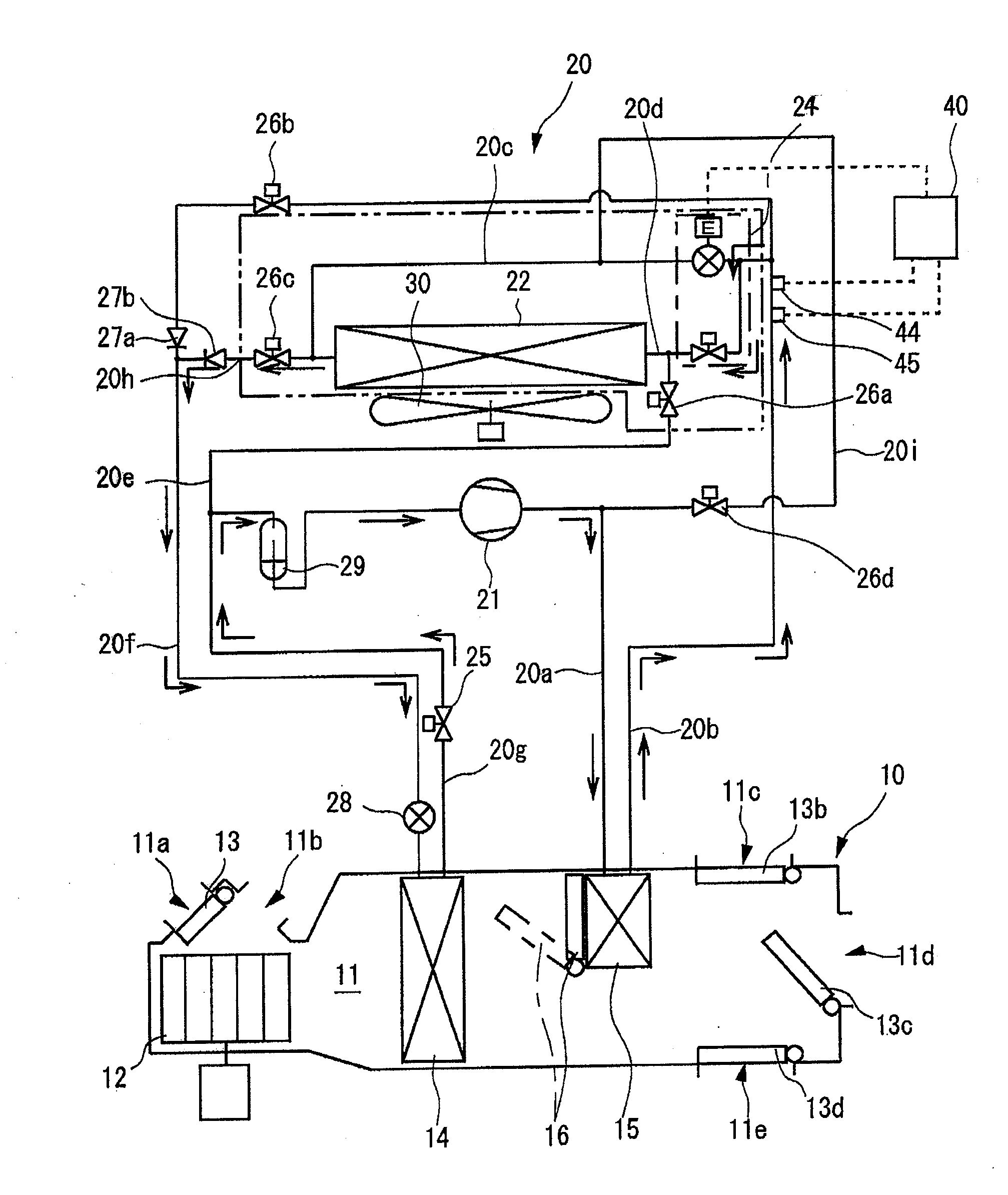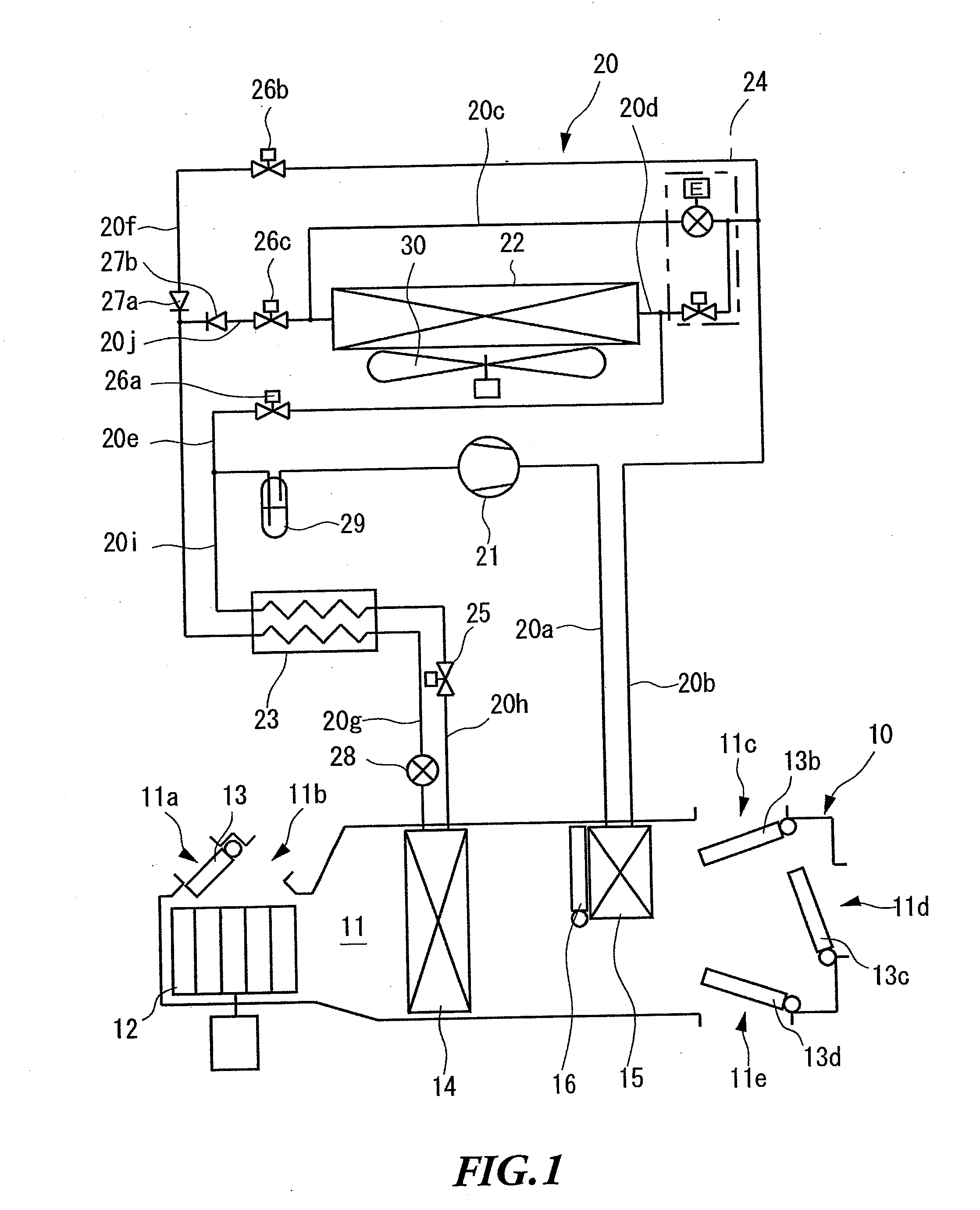Vehicle air conditioning apparatus
- Summary
- Abstract
- Description
- Claims
- Application Information
AI Technical Summary
Benefits of technology
Problems solved by technology
Method used
Image
Examples
embodiment 1
[0098]FIG. 1 to FIG. 10 show Embodiment 1 of the present invention.
[0099]As shown in FIG. 1, the vehicle air conditioning apparatus according to the present invention includes an air conditioning unit 10 provided in the vehicle interior, and a refrigerant circuit 20 formed across the vehicle interior and the outdoor.
[0100]The air conditioning unit 10 includes an air flow passage 11 that allows the air to be supplied to the vehicle interior to pass through. An outdoor air inlet 11a and an indoor air inlet 11b are provided in the first end side of the air flow passage 11. The outdoor air inlet 11a is configured to allow the outdoor air to flow into the air flow passage 11, and the indoor air inlet 11b is configured to allow the indoor air to flow into the air flow passage 11. Meanwhile, a foot outlet 11c, a vent outlet 11d and a defroster outlet 11e are provided in the second end side of the air flow passage 11. The foot outlet 11c is configured to allow the air flowing through the ai...
embodiment 2
[0180]FIG. 11 shows Here, the same components are assigned the same reference numerals as in the above-described embodiment.
[0181]In the vehicle air conditioning apparatus according to the present embodiment, the controller 40 performs an expansion part control process as shown in the flowchart in FIG. 11 with the same configuration as in Embodiment 1.
[0182](Step S41)
[0183]In step S41, the CPU determines whether the operation is the heating operation or the heating and dehumidifying operation. When determining that the operation is one of the heating operation and the heating and dehumidifying operation, the CPU moves the step to step S42. On the other hand, when determining that the operation is neither the heating operation nor the heating and dehumidifying operation, the CPU ends the expansion part control process.
[0184](Step S42)
[0185]In the step S42, the CPU calculates superheat SH of the refrigerant based on the temperature Tlp detected by the low-pressure refrigerant tempera...
embodiment 3
[0211]FIGS. 13 to 29 show Embodiment 3 of the present invention.
[0212]As shown in FIG. 13, the vehicle air conditioning apparatus according to the present invention includes the air conditioning unit 10 provided in the vehicle interior, and the refrigerant circuit 20 formed across the vehicle interior and the outdoor.
[0213]The air conditioning unit 10 includes the air flow passage 11 that allows the air to be supplied to the vehicle interior to pass through. The outdoor air inlet 11a and the indoor air inlet 11b are provided in the first end side of the air flow passage 11. The outdoor air inlet 11a is configured to allow the outdoor air to flow into the air flow passage 11, and the indoor air inlet 11b is configured to allow the indoor air to flow into the air flow passage 11. Meanwhile, the foot outlet 11c, the vent outlet 11d and the defroster outlet 11e are provided in the second end side of the air flow passage 11. The foot outlet 11c is configured to allow the air flowing thro...
PUM
 Login to View More
Login to View More Abstract
Description
Claims
Application Information
 Login to View More
Login to View More - R&D
- Intellectual Property
- Life Sciences
- Materials
- Tech Scout
- Unparalleled Data Quality
- Higher Quality Content
- 60% Fewer Hallucinations
Browse by: Latest US Patents, China's latest patents, Technical Efficacy Thesaurus, Application Domain, Technology Topic, Popular Technical Reports.
© 2025 PatSnap. All rights reserved.Legal|Privacy policy|Modern Slavery Act Transparency Statement|Sitemap|About US| Contact US: help@patsnap.com



